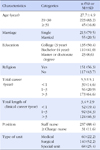Abstract
Purpose
The purpose of this study was to identify the effects of work stress, compassion fatigue and compassion satisfaction on burnout in clinical nurses.
Methods
The sample consisted of 268 nurses from two general hospitals located in Seoul and Gyunggi province. Data were analyzed using frequencies, percentages, means and standard deviations, t-test, ANOVA, Scheffé, Pearson Correlation and Hierarchial Multiple Regression.
Figures and Tables
Table 2
Descriptive Statistics for Work Stress, Compassion Fatigue, Compassion Satisfaction, and Burnout (N=268)

References
1. Abendroth M, Flannery J. Predicting the risk of compassion fatigue: A study of hospice nurses. J Hosp Palliat Nurs. 2006; 8:346–356.
2. Choe MO. The effects of the exposure on traumatic events, occupational qualities, and psychosocial resources on the compassion fatigue and burnout. Korean J Clin Psychol. 2009; 28:262–262.
3. Collins S, Long A. Working with psychological effects of trauma: Consequences for mental health-care workers-A literature review. J Psychiatr Ment Health Nurs. 2003; 10:417–424. http://dx.doi.org/10.1046/j.1365-2850.2003.00620.x.
4. Hooper C. Compassion satisfaction, burnout, and compassion fatigue among emergency nurses compared with nurses in other selected inpatient specialties. J Emerg Nurs. 2010; 36:420–427.
5. Figley CR. Compassion fatigue. coping with secondary traumatic stress disorder in those who treat the traumatized. New York, NY: Brunner/Mazel;1995.
6. Figley CR. Treating compassion fatigue. New York, NY: Brunner-Routledge;2002.
7. Gray-Toft P, Anderson JP. Stress among hospital nursing staff: Its cause and effects. Soc Sci Med A. 1981; 15:639–647.
8. Gu MO, Kim MJ. The development of the stress measurement tool for staff nurses working in the hospital. J Nurs Acad Soc. 1984; 14:28–37.
9. Hong GP. An analytic study on burnout in relation with personal and job related characteristics and social support. Seoul, Korea: Yonsei University;1984. Unpublished doctoral dissertation.
10. Kim EH. The study of job related stress among hospital nurse. Nurs Sci. 1996; 8(2):151–168.
11. Kim HJ, Choi H. Emergency nurses' professional quality of life: Compassion satisfaction, burnout, and secondary traumatic stress. J Korean Acad Nurs Adm. 2011; 18:320–328. http://dx.doi.org/10.11111/jkana.2012.18.3.320.
12. Kim HJ. The structural equation model of the burnout in clinical nurses based on CS-CF model. Seoul, Korea: Chung-Ang University;2013. Unpublished doctoral dissertation.
13. Ko JW, Yom YH. The role of social support in the relationship between job stress and job satisfaction/organizational commitment among hospital nurses. J Korean Acad Nurs. 2003; 33:265–274.
14. Leihter MP. Burnout as a developmental process: Considerations of models. In : Schaufeli WB, Maslash C, Marek T, editors. Professional burnout: Recent developments in theory and research. Washington, DC: Taylor & Francis;1993. p. 237–250.
15. Maslach C. A multidimensional theory of burnout. In : Cooper CL, editor. Theories of organizational stress. Oxford, New York: Oxford University Press;1998. p. 24–37.
16. National Institute for Occupational Safety and Health. Stress at work(Issue No. 99-101). Cincinnati, OH: Author;1999. 01.
17. O'Connor MF. On the etiology and effective management of professional distress and impairment among psychologists. Prof Psychol Res Pract. 2001; 32:345–350.
18. Park HJ. Emotional labour, emotional expression and burnout of clinical nurses. J Korean Acad Nurs Adm. 2009; 15:225–232.
19. Robertson S, Gow KM. How burned out employees perceive work stress and organizational burnout. In : Gow KM, Marek CJ, editors. Way finding through life's challenges: Coping and survival. New York, NY: Nova Science Publishers;2011. p. 385–402.
20. Slocum-Gori S. Understanding compassion satisfaction, compassion fatigue and burnout: A survey of the hospice palliative care workforce. Palliat Med. 2013; 27(2):172–178. http://dx.doi.org/10.1177/0269216311431311.
21. Stamm BH. Measuring compassion satisfaction as well as fatigue: Developmental history of the compassion satisfaction and fatigue test. Psychosocial stress series. New York, NY: Brunner-Routledge;2002.
22. Stamm BH. The concise ProQOL manual. 2nd ed. Pocatello, ID: ProQOL.org;2009.
23. Stebnicki MA. Stress and grief reactions among rehabilitation professionals: Dealing effectively with empathy fatigue. J Rehabil. 2000; 66:23–29.
24. Valent P. Survival strategies: A frame work for under standing secondary traumatic stress and coping in helpers. In : Figley CR, editor. Compassion fatigue: Secondary traumatic stress disorder in helper. New York, NY: Brunner-Mazel;1995.
25. Yoder EA. Compassion fatigue in nurse. Appl Nurs Res. 2010; 23(4):191–197. http://dx.doi.org/10.1016/j.apnr.2008.09.003.
26. Yoon GS, Kim SY. Influences of job stress and burnout on turnover intention of nurse. J Korean Acad Nurs Adm. 2010; 16:507–516.




 PDF
PDF ePub
ePub Citation
Citation Print
Print






 XML Download
XML Download